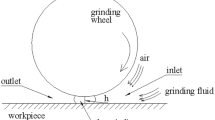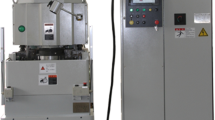Abstract
Due to the enclosed working environment and inadequate cooling, it is easy to produce excessive local temperatures in the double-face grinding machining process. Excessive local temperatures lead to a number of issues, including grinding wheel wear, workpiece burns, and surface quality degradation. In order to reduce the temperature with little coolant, a study on coolant distribution is necessary. This paper studies the effects of grinding wheel speed and workpiece speed on the coolant distribution law. The unidirectional flow field model in double-face grinding is established based on the contact equation of computational fluid dynamics, the Navier‒Stokes equation, and the turbulence equation. This model also considers the pores on the grinding wheel surface, the equivalent height of the abrasive particles, the geometric boundary, and the equivalent gap between the workpiece and the wheel. The results show that the component surface fluid velocity gradually rises from the inner to the outside diameter of the grinding wheel. The grinding area pressure distribution in different parameters is analyzed. The variance analysis of coolant distribution is carried out. It is found that there is a positive linear correlation between the grinding fluid flowing into the grinding zone and the grinding wheel speed. With the increase of wheel speed, the more liquid concentrates on the area where the coolant enters. And it is observed that 60 rad/s wheel speed leads to a more even coolant distribution and a flatter machined surface.


















Similar content being viewed by others
References
Kumar P, Kumar S, Kumar DD (2016) Grinding processes a review. Int J Eng Technol Manag Appl Sci 4(9):68–72
Kishore K, Sinha MK, Singh A, Archana MK, Gupta, Korkmaz ME (2022) A comprehensive review on the grinding process: advancements, applications and challenges. Proc Instit Mech Eng Part C: J Mech Eng Sci 09544062221110782. https://doi.org/10.1177/0954406222111078
Sun C, Lu Y, Xiu S, Li Q, Zhang P (2021) Analysis on the removal mechanism of disc grinding based on dynamic thermal–mechanical coupling. Int J Mech Mater Des. https://doi.org/10.1007/s10999-021-09539-9
Xiu S, Sun C, Duan J, Lan D, Li Q (2018) Study on the surface topography in consideration of the dynamic grinding hardening process. Int J Adv Manuf Technol 100(1–4):209–223. https://doi.org/10.1007/s00170-018-2744-9
Rowe WB (2013) Principles of modern grinding technology. William Andrew, Waltham
Maruda RW, Krolczyk GM, Nieslony P, Wojciechowski S, Michalski M, Legutko S (2016) The influence of the cooling conditions on the cutting tool wear and the chip formation mechanism. J Manuf Process 24:107–115. https://doi.org/10.1016/j.jmapro.2016.08.006
Seidel MW, Zösch A, Härtel K (2018) Grinding burn inspection. Forsch Ingenieurwes 82(3):253–259
Maruda RW, Krolczyk GM, Michalski M, Nieslony P, Wojciechowski S (2017) Structural and microhardness changes after turning of the AISI 1045 steel for minimum quantity cooling lubrication. J Mater Eng Perform 26(1):431–438
Wu X, Li C, Zhou Z, Nie X, Chen Y, Zhang Y et al (2021) Circulating purification of cutting fluid: an overview. Int J Adv Manuf Technol 117(9–10):2565–2600. https://doi.org/10.1007/s00170-021-07854-1
Wang X, Li C, Zhang Y, Ali HM, Sharma S, Li R, Yang M, Said Z, Liu X (2022) Tribology of enhanced turning using biolubricants: a comparative assessment. Tribology International. 174. https://doi.org/10.1016/j.triboint.2022.107766
Tang L, Zhang Y, Li C, Zhou Z, Nie X, Chen Y et al (2022) Biological stability of water-based cutting fluids: progress and application. Chin J Mech Eng 35(1). https://doi.org/10.1186/s10033-021-00667-z
Debnath S, Reddy MM, Yi QS (2014) Environmental friendly cutting fluids and cooling techniques in machining: a review. J Clean Prod 83:33–47. https://doi.org/10.1016/j.jclepro.2014.07.071
Sinha MK (2018) Experimental investigations in grinding of Inconel 718 using different environments and modelling of specific grinding energy. Dissertation, Indian Institute of Technology Delhi
Ang, J, Fan-Bo M, Shi-Chao X, Luo J-M (2012) Effective utilization of grinding fluids and implementation technique in grinding process. Machine Des Manuf (5):30–32
Yu-Gang W, Shao-Yong P, Lan-Song Y, Shi-Chao X (2014) Simulation analysis and experimental research on grinding fluid jet. Machine Des Manuf (11):216–219. https://doi.org/10.19356/j.cnki.1001-3997.2014.11.061
Wang CY, Zhang L, Yang CF (2014) Analysis and simulation of air flow field surrounding grinding wheel. In Advanced Materials Research, vol. 1027. Trans Tech Publications Ltd, pp 12–15
Zhenlu H, Changhe L, Sheng W, Qiang Z (2013) Modeling and simulation of air flow field in high-speed grinding. Manufacturing Technology & Machine Tool (5):110–115
Mandal B, Singh R, Das S, Banerjee S (2012) Development of a grinding fluid delivery technique and its performance evaluation. Mater Manuf Processes. 27(4):436–442. https://doi.org/10.1080/10426914.2011.585487
Majumdar S, Kumar S, Roy D, Chakraborty S, Das S (2017) Improvement of lubrication and cooling in grinding. Mater Manuf Processes. 33(13):1459–1465. https://doi.org/10.1080/10426914.2017.1364756
Majumdar S, Banerjee A, Das S, Chakroborty S, Zhou Z (2016) Experimental investigation and modelling on air layer formation around a rotating grinding wheel. Cogent Eng. 3 (1). https://doi.org/10.1080/23311916.2016.1183273
Sieniawski J, Nadolny K (2016) The effect upon grinding fluid demand and workpiece quality when an innovative zonal centrifugal provision method is implemented in the surface grinding of steel CrV12. J Clean Prod 113:960–972. https://doi.org/10.1016/j.jclepro.2015.11.017
do Nascimento WR, Yamamoto AA, de Mello HJ, Canarim RC, de Aguiar PR, Bianchi EC (2016) A study on the viability of minimum quantity lubrication with water in grinding of ceramics using a hybrid-bonded diamond wheel. Proc Inst Mech Eng Part B: J Eng Manuf 230(9):1630–1638. https://doi.org/10.1177/0954405415579016
Musavi SH, Davoodi B (2021) Risk assessment for hazardous lubricants in machining industry. Environ Sci Pollut Res 28(1):625–634
Li C, Zhang Q, Wang S, Jia D, Zhang D, Zhang Y, Zhang X (2015) Useful fluid flow and flow rate in grinding: an experimental verification. Int J Adv Manuf Technol 81(5):785–794
Deshpande S, Deshpande Y (2019) A review on cooling systems used in machining processes. Mater Today: Proc 18:5019–5031. https://doi.org/10.1016/j.matpr.2019.07.496
Dixit US, Sarma D, Davim JP (2012) Environmentally friendly machining[M]. Springer Science & Business Media, London
Rabiei F, Rahimi A, Hadad MJ (2017) Performance improvement of eco-friendly MQL technique by using hybrid nanofluid and ultrasonic-assisted grinding. Int J Adv Manuf Technol 93(1):1001–1015
Sidik NAC, Samion S, Ghaderian J, Yazid MNAWM (2017) Recent progress on the application of nanofluids in minimum quantity lubrication machining: a review. Int J Heat Mass Transf 108:79–89. https://doi.org/10.1016/j.ijheatmasstransfer.2016.11.105
Benes J (2007) Cutting the coolant. Am Mach 8:36
Davim JP (2013) Machining and machine-tools: research and development. Elsevier
Emami M, Sadeghi MH, Sarhan AAD, Hasani F (2014) Investigating the minimum quantity lubrication in grinding of Al2O3 engineering ceramic. J Clean Prod 66:632–643. https://doi.org/10.1016/j.jclepro.2013.11.018
Musavi SH, Davoodi B, Niknam SA (2018) Environmental-friendly turning of A286 superalloy. J Manuf Process 32:734–743. https://doi.org/10.1016/j.jmapro.2018.04.005
Rahim E, Ibrahim M, Rahim A, Aziz S, Mohid Z (2015) Experimental investigation of minimum quantity lubrication (MQL) as a sustainable cooling technique. Procedia CIRP 26:351–354. https://doi.org/10.1016/j.procir.2014.07.029
Dogra M, Sharma VS, Dureja JS, Gill SS (2018) Environment-friendly technological advancements to enhance the sustainability in surface grinding- a review. J Clean Prod 197:218–231. https://doi.org/10.1016/j.jclepro.2018.05.280
Li H, Zhang Y, Li C, Zhou Z, Nie X, Chen Y et al (2022) Cutting fluid corrosion inhibitors from inorganic to organic: progress and applications. Korean J Chem Eng 39(5):1107–1134. https://doi.org/10.1007/s11814-021-1057-0
Xu W, Li C, Zhang Y, Ali HM, Sharma S, Li R et al (2022) Electrostatic atomization minimum quantity lubrication machining: from mechanism to application. Int J Extreme Manuf 4(4). https://doi.org/10.1088/2631-7990/ac9652
Jia D, Li C, Wang S, Zhang Q (2014) Investigation into distributing characteristic of suspend particulate in MQL grinding. Manuf Technol Mach Tool 2(2):58–61
Zhao W, Ning H, Liang L, Yang Y, Shi Q (2014) Investigation on the influence of system parameters on ambient air quality in minimum quantity lubrication milling process. J Mech Eng-En 50(13):184–189
Singh G, Aggarwal V, Singh S, Singh B, Sharma S, Singh J, Li C, Ilyas RA, Mohamed A (2022) Experimental investigation and performance optimization during machining of Hastelloy C-276 using green lubricants. Materials (Basel). 15(15). https://doi.org/10.3390/ma15155451
Cui X, Li C, Zhang Y, Said Z, Debnath S, Sharma S et al (2022) Grindability of titanium alloy using cryogenic nanolubricant minimum quantity lubrication. J Manuf Process 80:273–286. https://doi.org/10.1016/j.jmapro.2022.06.003
Cui X, Sun N, Guo J, Ma J, Ming P (2022) Green multi-biomimetic spontaneous oil-transport microstructure and its effects on energy consumption in sustainable intermittent cutting. J Clean Prod 367. https://doi.org/10.1016/j.jclepro.2022.133035
Cabanettes F, Faverjon P, Sova A, Dumont F, Rech J (2016) MQL machining: from mist generation to tribological behavior of different oils. Int J Adv Manuf Technol 90(1–4):1119–1130. https://doi.org/10.1007/s00170-016-9436-0
Mihić SD, Cioc S, Marinescu ID, Weismiller MC (2013) Detailed study of fluid flow and heat transfer in the abrasive grinding contact using computational fluid dynamics methods. J Manuf Sci Eng 135(4)
Qiang Z, Chang-He L, Sheng W (2013) Hydrodynamic pressure modeling and experimental verification of grinding zone between smooth surfaces. Modular Machine Tool & Automatic Manufacturing Technique (10):24–27
Morgan M, Jackson A, Wu H, Baines-Jones V, Batako A, Rowe W (2008) Optimisation of fluid application in grinding. CIRP Ann 57(1):363–366. https://doi.org/10.1016/j.cirp.2008.03.090
LIU Y, LIU W, LIU D (2009) Pore forming effect of different inorganic ammonium salts applied on vitrified bond CBN wheels EJ~. Diamond & Abrasives Engineering 6:15–18
Yan G, Xiaowei X, Liang Y (2009) Research on ceramic metal compound bond used in superhard CBN abrasive tools. J Synth Crystals 38(1):186–190. https://doi.org/10.16553/j.cnki.issn1000-985x.2009.s1.060
Yan QS, Zhang ZQ, Syoji K (2001) Study on performance of CBN cup quill for face grinding. In Key Engineering Materials, vol 202. Trans Tech Publications Ltd, pp 79–84
Feng Z, Riyao C (1994) Test for surface roughness by CBN wheel grinding. Aeronautical Manufacturing Technology (6):13–14
Shengming Y, Fenghao F (2006) The equivalent viscosity coefficients of lubrication with emulsion. Lubrication Engineering-Huangpu- 3(175):65
Fenghao F, Wei C, Xinling J (2005) Research on the viscosity coefficients of emulsion. Coal Mine Mach (06): p. 21–22.https://doi.org/10.13436/j.mkjx.2005.06.012
Funding
This work was supported by the National Natural Science Foundation of China (Grant No. 52175383).
Author information
Authors and Affiliations
Contributions
All authors contributed to the study conception and design. Material preparation was performed by Kong Xiangna, Yao Yunlong, and Zou Xiannan. Data collection was performed by Li Qingliang, Zhang Gensheng, and Zou Xiannan. Analyses were established by Zhang Gensheng and Zou Xiannan. The first draft of the manuscript was written by Zou Xiannan and all authors commented on previous versions of the manuscript and Xiu Shichao supervised the project and reviewed and edited the article. All authors read and approved the final manuscript.
Corresponding author
Ethics declarations
Competing interests
The authors declare no competing interests.
Additional information
Publisher's note
Springer Nature remains neutral with regard to jurisdictional claims in published maps and institutional affiliations.
Rights and permissions
Springer Nature or its licensor (e.g. a society or other partner) holds exclusive rights to this article under a publishing agreement with the author(s) or other rightsholder(s); author self-archiving of the accepted manuscript version of this article is solely governed by the terms of such publishing agreement and applicable law.
About this article
Cite this article
Zou, X., Zhang, G., Li, Q. et al. Flow field analysis of grinding fluid in double-face grinding. Int J Adv Manuf Technol 131, 2071–2085 (2024). https://doi.org/10.1007/s00170-022-10666-6
Received:
Accepted:
Published:
Issue Date:
DOI: https://doi.org/10.1007/s00170-022-10666-6




